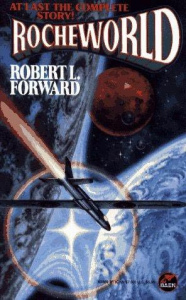For this week’s Flashback Friday post, I’m honored to have educator and writer, CJ Record, here to do a guest post on what speculative fiction novel influenced him as a writer.
 I’ve been chewing on science fiction novels since I could start selecting my own books from the library. The Scholastic Book Sales lady smiled when she saw me coming. So when Raven asked on Twitter: “What SF/F novels from childhood influenced your writing?” I had an actual dilemma: what to choose?
I’ve been chewing on science fiction novels since I could start selecting my own books from the library. The Scholastic Book Sales lady smiled when she saw me coming. So when Raven asked on Twitter: “What SF/F novels from childhood influenced your writing?” I had an actual dilemma: what to choose?
I mean, there are the classics, such as Madeline L’Engle’s A Wrinkle in Time series and C.S. Lewis’ Space
trilogy. Robert Heinlein had his well-turned phrases (even though I was already looking askance at his gender roles). There are the obvious Clark or Crichton choices. And then there were the bookshelves with failure loads of Star Trek novels. (No, literally: one shelf did break.)
But the book that kept coming up in my mind was Rocheworld by Robert Forward. Extended from a short story into a novel and expanded again for a 1990 publication, then carried on through four more collaborative books, Rocheworld is a tale of the first space flight to a nearby star. When the characters get there, they explore a unique close binary planetary configuration and make contact with the resident sentient life forms of one planet. There is also the obligatory human drama that occurs when you put a group of adult humans in a tin can for an extended period of time (which is fortunately not the focus of the text). I’ll leave out most of the plot, since that’s not really what’s memorable. What makes it stick in my mind are three things it did that I’ve since found I always find in sci-fi I like.
You can put the Science in the Fiction
We could go around and around and around about the worthiness of “hard” sci-fi versus “soft” sci-fi, but I don’t feel up to terrorizing Ms. Oak’s blog this week, past saying that there’s validity to both genres. Rocheworld, like others I’ve read, seems to work best when it’s splitting the difference between the extremes. All of the human technology is “probable”: lightsails propelled by Terran-based collimated lasers, lightweight gliders designed to take advantage of the gravitational oddities, drug-induced comas with crew alternating awake periods. So much of the technology appears to be completely possible – and back-checked.
Forward takes the time to explain some of the physics and science: not to the depth some other authors, not in an amount that impedes the flow of the story, but enough to show that he did the research.
You can put the Fiction in the Science
Science fiction is, to steal a phrase, about “exploring new worlds”. Rocheworld does that very well. Gone is the typical, expected single-planet-plus-moon. Instead, Forward presents an orbital configuration of two planets of equal mass so closely positioned that they’re ovoid due to gravity. In fact, they share an atmosphere, and during certain tidal conjunctions, the ocean can surge over the gap due to the specific gravity fields created by the form. Mathematically possible, if improbable.
In a more man-made example, the robot crewman, the “Christmas Bush”, is a fractal structure of smaller and smaller branches, down to microscopic levels. Each branch ended in a diode, and the entire structure is self-powered and reasonably self-aware. All of this, contained in something that, folded up, isn’t larger than a broomstick. Theoretically conceivable, but nowhere near the technology level of his first draft in 1980.
And yet, the science is there for these to eventually be possible. After doing a little bit of research, Forward wrote for the horizons. The book crosses over the edges of unexpected and unlikely, but it’s memorable.
You can let your aliens be alien
To continue the prior quote, “…and seek out strange new life”. And yet the show that quote is from? Not so hot on non-bilateral bipeds. In Rocheworld, the aliens are, well, alien. The best description is asexual technicolor bags of protoplasm floating in a world-ocean, using a combination of texture, color, and a panoply of ASCII characters to represent their own names. They have very distinct personalities and goals and even technological awareness. But they use senses that are very divergent from humans – it’s only over the course of the book that one of them “discovers” long-distance sight. The culture shock when the two species meet is truly memorable.
Are they a possible biological life form? Who knows – we’re still finding things on this ball of rock that we didn’t know could exist. On a different ball of rock, there are even more possibilities. Sci-fi is about possibilities, and has no reason to not go the distance.
Is Rocheworld the perfect sci-fi tale? Of course not – some of the gender portrayals among the human crew are problematic, to say the least. But the tale itself is a great example of sci-fi that has stuck in my mind for twenty-odd years now.

